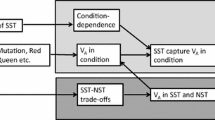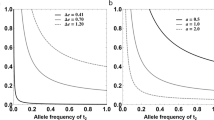Abstract
Phenotypic plasticity, the ability to adjust phenotype to the exposed environment, is often advantageous for organisms living in heterogeneous environments. Although the degree of plasticity appears limited in nature, many studies have reported low costs of plasticity in various species. Existing studies argue for ecological, genetic, or physiological costs or selection eliminating plasticity with high costs, but have not considered costs arising from sexual selection. Here, we show that sexual selection caused by mate choice can impede the evolution of phenotypic plasticity in a trait used for mate choice. Plasticity can remain low to moderate even in the absence of physiological or genetic costs, when individuals phenotypically adapted to contrasting environments through plasticity can mate with each other and choose mates based on phenotypic similarity. Because the non-choosy sex (i.e., males) with lower degrees of plasticity are more favored in matings by the choosy sex (i.e., females) adapted to different environments, directional selection toward higher degrees of plasticity is constrained by sexual selection. This occurs at intermediate strengths of female choosiness in the range of the parameter value we examined. Our results demonstrate that mate choice is a potential source of an indirect cost to phenotypic plasticity in a sexually selected plastic trait.





Similar content being viewed by others
References
Auld JR, Agrawal AA, Relyea RA (2010) Re-evaluating the costs and limits of adaptive phenotypic plasticity. Philos Trans R Soc 277:503–511
Berrigan D, Scheiner SM (2004) Modeling the evolution of phenotypic plasticity. In: Dewitt TJ, Scheiner SM (eds) Phenotypic plasticity: functional and conceptual approaches. Oxford University Press, New York, pp 82–97
Bolnick DI (2004) Waiting for sympatric speciation. Evolution 58:895–899
Bolnick DI, Kirkpatrick M (2012) The relationship between intraspecific assortative mating and reproductive isolation between divergent populations. Curr Zool 58:484–492
Bradshaw AD (1965) Evolutionary significance of phenotypic plasticity in plants. Adv Genet 13:115–155
Callahan HS, Maughan H, Steiner UK (2008) Phenotypic plasticity, costs of phenotypes, and costs of plasticity: toward an integrative view. Ann NY Acad Sci 1133:44–66
Conte GL, Schluter D (2013) Experimental confirmation that body size determines mate preference via phenotype matching in a stickleback species pair. Evolution 67:1477–1484
Cornwallis CK, Uller T (2010) Toward an evolutionary ecology of sexual traits. Trends Ecol Evol 25:145–152
Crespi BJ (1989) Causes of assortative mating in arthropods. Anim Behav 38:980–1000
Crispo E (2008) Modifying effects of phenotypic plasticity on interactions among natural selection, adaptation and gene flow. J Evol Biol 21:1460–1469
Crowley PH, Travers SE, Linton MC, Cohn SL, Sih A, Sargent RC (1991) Mate density, predation risk, and the seasonal sequence of mate choices: a dynamic game. Am Nat 137:567–596
de Cara MAR, Barton NH, Kirkpatrick M (2008) A model for the evolution of assortative mating. Am Nat 171:580–596
Dechaine JM, Johnson JA, Brock MT et al (2007) Constraints on the evolution of adaptive plasticity: costs of plasticity to density are expressed in segregating progenies. N Phytol 176:874–882
Dewitt TJ, Scheiner SM (2004) Phenotypic plasticity: functional and conceptual approaches. Oxford University Press, Oxford
Dewitt TJ, Sih A, Wilson DS (1998) Costs and limits of phenotypic plasticity. Trends Ecol Evol 13:77–81
Dieckmann U, Doebeli M (1999) On the origin of species by sympatric speciation. Nature 400:354–357
Doebeli M (1996) A quantitative genetic competition model for sympatric speciation. J Evol Biol 9:893–909
Doebeli M, Blok HJ, Leimar O et al (2007) Multimodal pattern formation in phenotype distributions of sexual populations. Proc R Soc B 274:347–357
Edelaar P, Siepielski AM, Clobert J (2008) Matching habitat choice causes directed gene flow: a neglected dimension in evolution and ecology. Evolution 62:2462–2472
Ernande B, Dieckmann U (2004) The evolution of phenotypic plasticity in spatially structured environments: implications of intraspecific competition, plasticity costs and environmental characteristics. J Evol Biol 17:613–628
Fitzpatrick BM (2012) Underappreciated consequences of phenotypic plasticity for ecological speciation. Int J Ecol 2012:1–12
Fowler-Finn KD, Rodriguez RL (2012) Experience-mediated plasticity in mate preferences: mating assurance in a variable environment. Evolution 66:459–468
Garduno-Paz MV, Adams CE (2010) Discrete prey availability promotes foraging segregation and early divergence in Arctic charr, Salvelinus alpinus. Hydrobiologia 650:15–26
Gavrilets S (2004) Fitness landscapes and the origin of species. Princeton University Press, Princeton
Geiselhardt S, Otte T, Hilker M (2012) Looking for a similar partner: host plants shape mating preferences of herbivorous insects by altering their contact pheromones. Ecol Lett 15:971–977
Gillespie DT (1977) Exact stochastic simulation of coupled chemical reactions. J Phys Chem 81:2340–2361
Greenfield MD, Rodriguez RL (2004) Genotype-environment interaction and the reliability of mating signals. Anim Behav 68:1461–1468
Griffith SC, Sheldon BC (2001) Phenotypic plasticity in the expression of sexually selected traits: neglected components of variation. Anim Behav 61:987–993
Härdling R, Kokko H (2005) The evolution of prudent choice. Evol Ecol Res 7:697–715
Hebets EA, Vink CJ (2007) Experience leads to preference: experienced females prefer brush-legged males in a population of syntopic wolf spiders. Behav Ecol 18:1010–1020
Huber SK, De Leon LF, Hendry AP et al (2007) Reproductive isolation of sympatric morphs in a population of Darwin’s finches. Proc R Soc B 274:1709–1714
Ingleby FC, Hunt J, Hosken DJ (2010) The role of genotype-by-environment interactions in sexual selection. J Evol Biol 23:2031–2045
Jiang Y, Bolnick DI, Kirkpatrick M (2013) Assortative mating in animals. Am Nat 18:E125–E138
Kingsolver JG, Hoekstra HE, Hoekstra JM et al (2001) The strength of phenotypic selection in natural populations. Am Nat 157:245–261
Kirkpatrick M, Nuismer SL (2004) Sexual selection can constrain sympatric speciation. Proc R Soc B 271:687–693
Kirkpatrick M, Ravigné V (2002) Speciation by natural and sexual selection. Am Nat 159:S22–S35
Kondrashov AS, Kondrashov FA (1999) Interactions among quantitative traits in the course of sympatric speciation. Nature 400:351–354
Kondrashov AS, Shpak M (1998) On the origin of species by means of assortative mating. Proc R Soc B 265:2273–2278
Kozak GM, Head ML, Lackey ACR, Boughman JW (2013) Sequential mate choice and sexual isolation in threespine stickleback species. J Evol Biol 26:130–140
Lande R (1981) Models of speciation by sexual selection on polygenic traits. Proc Natl Acad Sci USA 78:3721–3725
Langerhans AK, Makowicz AM (2009) Shared and unique features of morphological differentiation between predator regimes in Gambusia caymanensis. J Evol Biol 22:2231–2242
Langerhans AK, Gifford ME, Joseph EO (2007) Ecological speciation in Gambusia fishes. Evolution 61:2056–2074
Levin DA (2009) Flowering-time plasticity facilitates niche shifts in adjacent populations. N Phytol 183:661–666
Lind MI, Johansson F (2009) Costs and limits of phenotypic plasticity in island populations of the common frog Rana temporaria under divergent selection pressures. Evolution 63:1508–1518
Lind MI, Ingvarsson PK, Johansson H et al (2011) Gene flow and selection on phenotypic plasticity in an island system of Rana temporaria. Evolution 65:684–697
Maan ME, Seehausen O (2011) Ecology, sexual selection and speciation. Ecol Lett 14:591–602
Martin CH (2013) Strong assortative mating by diet, color, size, and morphology but limited progress toward sympatric speciation in a classic example: Cameroon crater lake cichlids. Evolution 67:2114–2123
McKinnon JS, Mori S, Blackman BK, David L, Kingsley DM, Jamieson L, Chou J, Schluter D (2004) Evidence for ecology’s role in speciation. Nature 429(6989):294–298
Miner BG, Sultan SE, Morgan SG et al (2005) Ecological consequences of phenotypic plasticity. Trends Ecol Evol 20:685–692
Nagel L, Schluter D (1998) Body size, natural selection, and speciation in sticklebacks. Evolution 52:209–218
Olsson J, Eklöv P (2005) Habitat structure, feeding mode and morphological reversibility: factors influencing phenotypic plasticity in perch. Evol Ecol Res 7:1109–1123
Olsson J, Svanbäck R, Eklöv P (2006) Growth rate constrain morphological divergence when driven by competition. Oikos 115:15–22
Pigliucci M (2005) Evolution of phenotypic plasticity: where are we going now? Trends Ecol Evol 20:481
Relyea RA (2002) Cost of phenotypic plasticity. Am Nat 159:272–282
Rosenzweig ML, MacArthur RH (1963) Graphical representation and stability conditions of predator–prey interactions. Am Nat 97:209–223
Rueffler C, van Dooren TJM, Leimar O et al (2006) Disruptive selection and then what? Trends Ecol Evol 21:238–245
Scheiner SM (1993) Genetics and evolution of phenotypic plasticity. Annu Rev Ecol Syst 24:35–68
Scheiner SM (2013) The genetics of phenotypic plasticity. XII. Temporal and spatial heterogeneity. Ecol Evol 3:4596–4609
Scheiner SM, Lyman RF (1991) The genetics of phenotypic plasticity. II. Response to selection. J Evol Biol 4:23–50
Schlichting CD, Levin DA (1986) Phenotypic plasticity: an evolving plant character. Biol J Linn Soc 29:37–47
Schlichting CD, Pigliucci M (1998) Phenotypic evolution: a reaction norm perspective. Sinauer Associates, Sunderland
Servedio MR, Kopp M (2012) Sexual selection and magic traits in speciation with gene flow. Curr Zool 58:510–516
Servedio MR, Van Doorn GS, Kopp M et al (2011) Magic traits in speciation: ‘magic’ but not rare? Trends Ecol Evol 26:389–397
Snowberg LK, Bolnick DI (2008) Assortative mating by diet in a phenotypically unimodal but ecologically variable population of stickleback. Am Nat 172:733–739
Snowberg LK, Bolnick DI (2012) Partitioning the effects of spatial isolation, nest habitat, and individual diet in causing assortative mating within a population of threespine stickleback. Evolution 66:3582–3594
Sultan SE, Spencer HG (2002) Metapopulation structure favors plasticity over local adaptation. Am Nat 160:271–283
Svanbäck R, Eklöv P (2006) Genetic variation and phenotypic plasticity: causes of morphological and dietary variation in Eurasian perch. Evol Ecol Res 8:37–49
Svanbäck R, Pineda-Krch M, Doebeli M (2009) Fluctuating population dynamics promotes the evolution of phenotypic plasticity. Am Nat 174:176–189
Takimoto G, Higashi M, Yamamura N (2000) A deterministic genetic model for sympatric speciation by sexual selection. Evolution 54:1870–1881
Thibert-Plante X, Gavrilets S (2013) Evolution of mate choice and the so-called magic traits in ecological speciation. Ecol Lett 16:1004–1013
Thibert-Plante X, Hendry A (2011) The consequences of phenotypic plasticity for ecological speciation. J Evol Biol 24:326–342
Valladares F, Gianoli E, Gomez JM (2007) Ecological limits to plant phenotypic plasticity. N Phytol 176:749–763
van Buskirk J, Steiner UK (2009) The fitness costs of developmental canalization and plasticity. J Evol Biol 22:852–860
Van Doorn GS, Edelaar P, Weissing FJ (2009) On the origin of species by natural and sexual selection. Science 326:1704
Wagner WE, Smeds MR, Wiegmann DD (2001) Experience affects female responses to male song in the variable field cricket Gryllus lineaticeps (Orthoptera, Gryllidae). Ethology 107:769–776
Weissing FJ, Edelaar P, van Doorn GS (2011) Adaptive speciation theory: a conceptual review. Behav Ecol Sociobiol 65:461–480
West-Eberhard MJ (2003) Speciation. West-Eberhard developmental plasticity and evolution. Oxford University Press, Oxford, pp 526–563
Whitman DW, Agrawal AA (2009) What is phenotypic plasticity and why is it important? In: Whitman DW, Ananthakrishnan TN (eds) Phenotypic plasticity of insects. Science, Enfield, pp 1–63
Windig JJ, de Kovel CGF, de Jong G (2004) Genetics and mechanics of plasticity. In: Dewitt TJ, Scheiner SM (eds) Phenotypic plasticity: functional and conceptual approaches. Oxford University Press, Oxford, pp 31–49
Acknowledgments
We thank Henrik Sjödin, Magnus Lindh, Sander van Doorn, and EvolClub for fruitful discussions on the ideas and interpretations of the results. We are grateful to Göran Englund, Kenyon Mobley, Xavier Thibert-Plante, and Wojciech Uszko for their comments on earlier drafts, which improved the scientific quality and readability of the manuscript. HPC2N at Umeå University provided resources and support for computation. This project was funded by financial support from Umeå University to E.N. and Å.B. and a grant from the Swedish Research Council to R.S.
Author information
Authors and Affiliations
Corresponding author
Electronic supplementary material
Below is the link to the electronic supplementary material.
Rights and permissions
About this article
Cite this article
Nonaka, E., Brännström, Å. & Svanbäck, R. Assortative mating can limit the evolution of phenotypic plasticity. Evol Ecol 28, 1057–1074 (2014). https://doi.org/10.1007/s10682-014-9728-5
Received:
Accepted:
Published:
Issue Date:
DOI: https://doi.org/10.1007/s10682-014-9728-5




